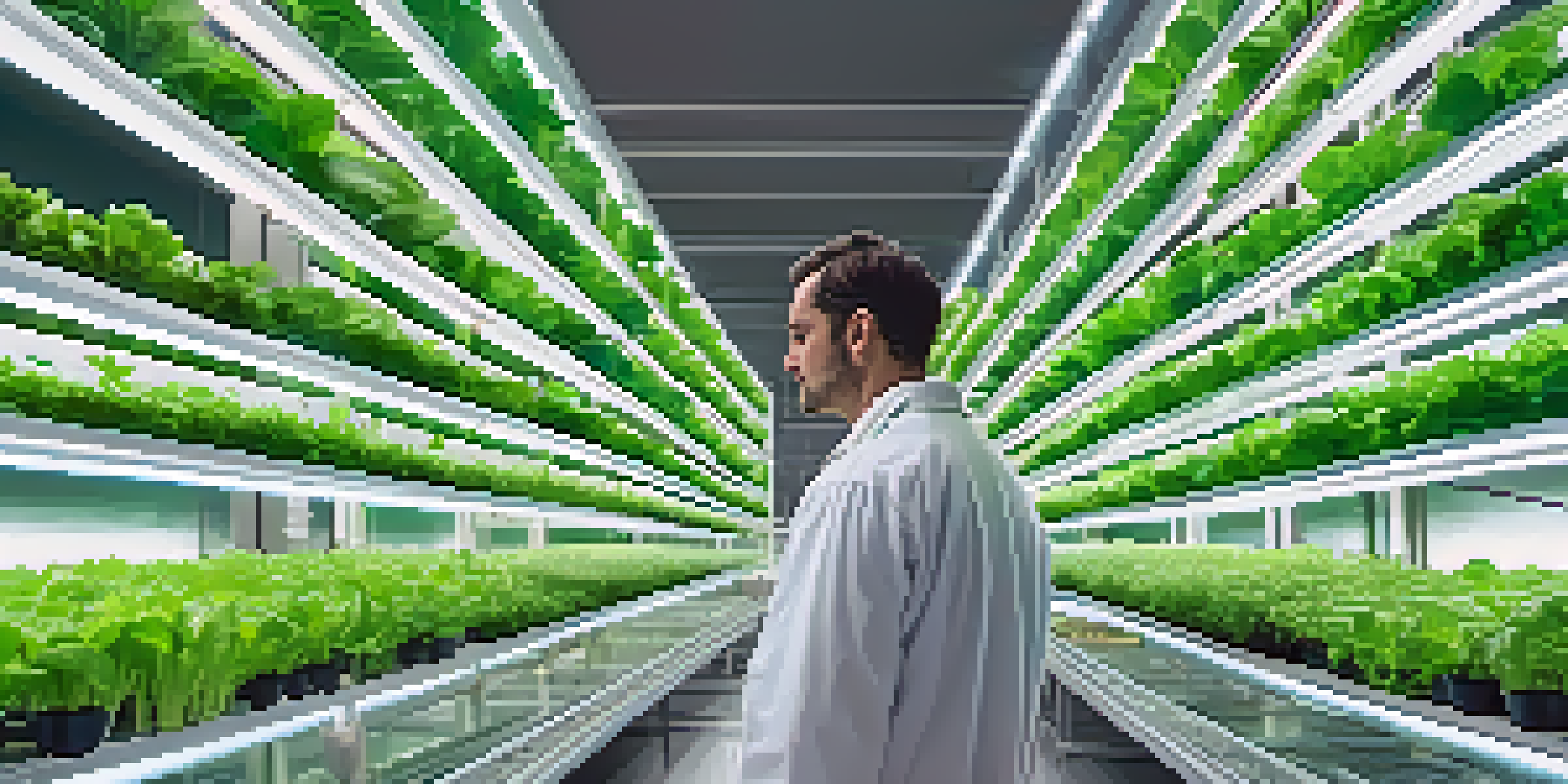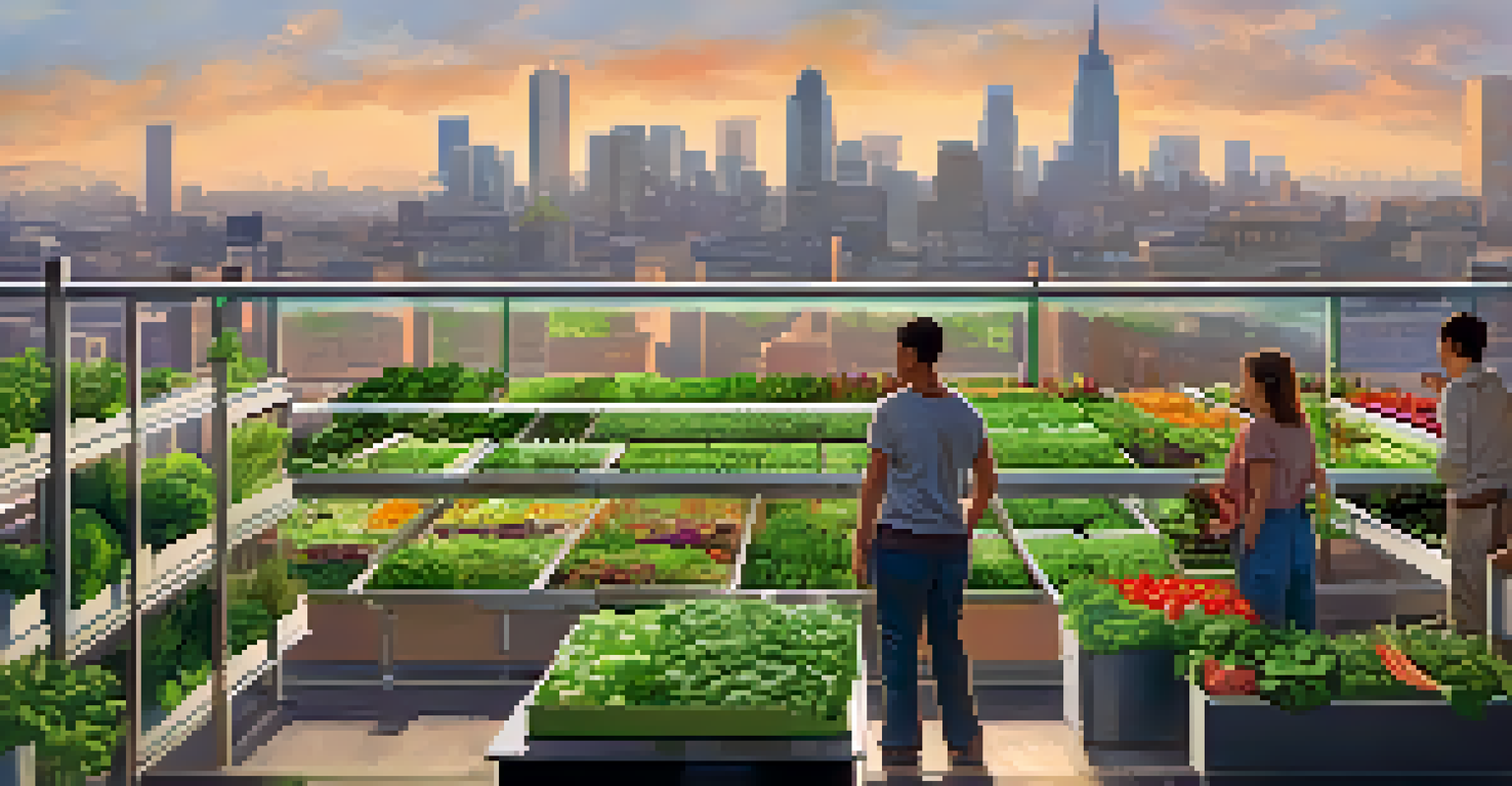Vertical Farming: A Revolutionary Practice in California's Farms

Introduction to Vertical Farming in California
Vertical farming is an innovative agricultural practice that has begun to take root in California. This method involves growing crops in vertically stacked layers, often using controlled-environment agriculture technology. As the state faces challenges like water scarcity and urban sprawl, vertical farming presents a promising solution to these pressing issues.
Vertical farming is not just about growing food; it's about growing a sustainable future.
California is known for its diverse agriculture, but traditional farming methods can be resource-intensive. By adopting vertical farming, farmers can produce food more sustainably and efficiently. This approach not only maximizes space but also minimizes water usage, making it an attractive option for many.
Moreover, vertical farming can be implemented in urban areas, bringing fresh produce closer to consumers. This shift not only supports local economies but also reduces transportation emissions, making it a win-win for both the environment and communities.
The Benefits of Vertical Farming
One of the most significant benefits of vertical farming is its ability to conserve water. Traditional farming requires large amounts of water, often leading to depletion of local resources. In contrast, vertical farms can use up to 90% less water through systems like hydroponics and aeroponics, which deliver nutrients directly to the plants' roots.

Additionally, vertical farming allows for year-round crop production, unaffected by seasonal changes or weather conditions. This consistent supply of fresh produce can help stabilize prices and ensure that communities have access to food regardless of external factors. Imagine enjoying fresh strawberries in December instead of waiting for summer!
Vertical Farming Reduces Resource Use
Vertical farming conserves water and minimizes pesticide use, making it a sustainable alternative to traditional agriculture.
Another advantage is the reduced need for pesticides and herbicides in vertical farming. With controlled environments, these farms can minimize pest issues naturally, leading to healthier produce. Consumers increasingly seek organic options, and vertical farming can meet this demand while promoting sustainable practices.
Challenges Facing Vertical Farming
Despite its many advantages, vertical farming is not without challenges. One of the primary hurdles is the initial investment required to set up these high-tech systems. The costs for equipment, technology, and infrastructure can be significant, and many farmers may hesitate to make such a leap without guaranteed returns.
The future of farming is not in the fields, but in the buildings of our cities.
Moreover, vertical farming relies heavily on energy to maintain optimal growing conditions. As energy prices fluctuate, this can impact the overall profitability of these operations. Farmers must find ways to balance energy consumption with production efficiency to ensure their ventures are sustainable in the long run.
Lastly, there is still a learning curve associated with transitioning to vertical farming. Farmers used to traditional methods may need training to adapt to new technologies and practices. However, with the right resources and support, many are finding success in making this transition.
Technological Innovations in Vertical Farming
Technology plays a crucial role in the success of vertical farming. From LED lighting systems that mimic sunlight to climate control technologies that optimize growth conditions, innovation is at the heart of this practice. These advancements not only enhance crop yield but also allow for precise monitoring of plant health.
For instance, some vertical farms use sensors to track humidity, temperature, and nutrient levels, adjusting conditions in real-time. This data-driven approach ensures that plants receive exactly what they need to thrive. By leveraging technology, farmers can make informed decisions, improving their overall production efficiency.
Urban Farming Enhances Food Access
By implementing vertical farms in urban areas, fresh produce can be delivered closer to consumers, supporting local economies.
Additionally, robotic systems are being integrated into vertical farms, further streamlining operations. These robots can handle tasks like planting, harvesting, and packaging, reducing labor costs and increasing productivity. As technology continues to evolve, it promises to reshape the future of farming in California and beyond.
Success Stories of Vertical Farming in California
Several successful vertical farming projects have emerged across California, setting examples for others to follow. One notable example is an urban farm in Los Angeles that has transformed a former warehouse into a thriving vertical farm. This facility not only produces leafy greens and herbs but also educates the community about sustainable practices.
Another inspiring case is a vertical farm in San Diego that specializes in microgreens. These nutrient-dense plants are grown in a controlled environment, allowing for rapid growth and high yields. The farm's success has garnered attention, with local restaurants eager to source fresh microgreens for their dishes.
These success stories demonstrate that vertical farming isn’t just a theoretical concept; it’s becoming a reality. As more farmers embrace this approach, the potential for growth and innovation in California's agricultural landscape becomes even more promising.
The Future of Vertical Farming in California
Looking ahead, the future of vertical farming in California appears bright. As consumers increasingly prioritize fresh, local produce, the demand for vertical farms is likely to grow. This trend could lead to more investments in technology and infrastructure, making it easier for new farmers to enter the market.
Furthermore, as awareness of environmental sustainability rises, vertical farming positions itself as a key player in addressing food security challenges. With its minimal resource use and potential to produce high-quality food, vertical farming can help California meet the needs of its growing population while preserving the environment.
Tech Innovations Drive Vertical Farming
Advancements in technology, such as climate control and robotics, are enhancing crop yields and operational efficiency in vertical farming.
Ultimately, collaboration among farmers, technology providers, and policymakers will be essential for the continued success of vertical farming. By working together, they can create a supportive ecosystem that fosters innovation and sustainability, paving the way for a more resilient agricultural future.
Conclusion: Embracing Vertical Farming
In conclusion, vertical farming is revolutionizing California's agricultural landscape, offering sustainable solutions to some of the most pressing challenges. With its ability to conserve resources, produce food year-round, and minimize environmental impact, it represents a significant shift in how we think about farming.
As more farmers adopt vertical farming techniques, we can expect to see a transformation in food production, accessibility, and sustainability. The success stories emerging from California serve as a testament to the potential of this innovative approach, inspiring others to follow suit.

By embracing vertical farming, California can lead the way in creating a more sustainable and resilient food system. It's an exciting time for agriculture, and with continued support and innovation, vertical farming could become a staple in the state's farming practices.